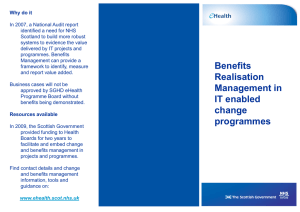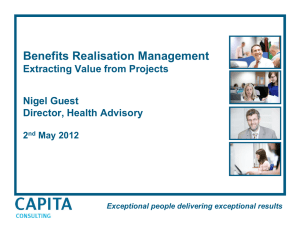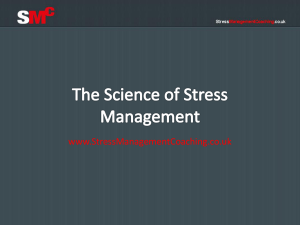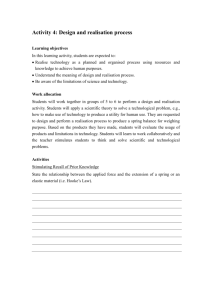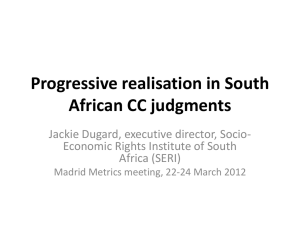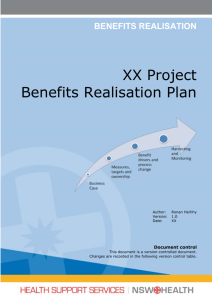The Relationship between Actual Investment and Survey
advertisement
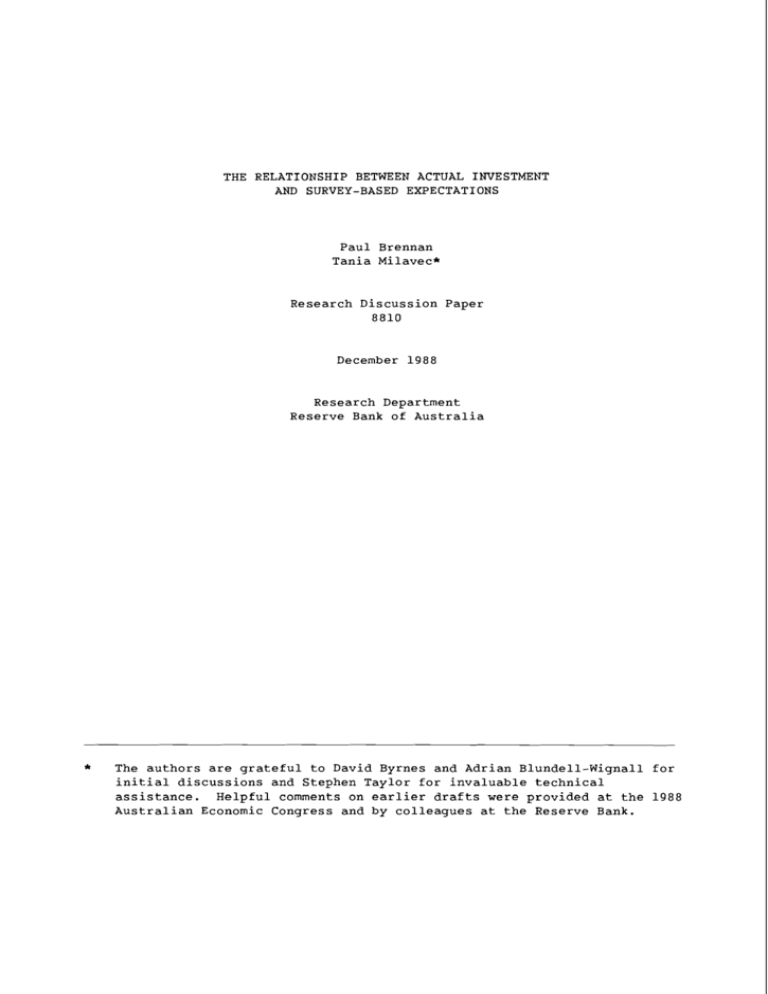
THE RELATIONSHIP BETWEEN ACTUAL INVESTMENT AND SURVEY-BASED EXPECTATIONS Paul Brennan Tania Milavec* Research Discussion Paper 8810 December 1988 Research Department Reserve Bank of Australia * The authors are grateful to David Byrnes and Adrian Blundell-Wignall for initial discussions and Stephen Taylor for invaluable technical assistance. Helpful comments on earlier drafts were provided at the 1988 Australian Economic Congress and by colleagues at the Reserve Bank. ( i) ABSTRACT Empirical investment models have generally provided a poor explanation of trends in business investment. One reason for this poor performance has been the failure to satisfactorily incorporate expectations. In this paper the usefulness of survey-based expectations is explored. Although these expectations are used extensively in forecasting business investment there has been little study of the systematic relationship between the expectations and actual outcomes. It is found that surprises in short-term interest rates and cyclical factors are the most important quantitative determinants of the relationship between survey expectations and actual outcomes for both construction and equipment investment. ( ii) TABLE OF CONTENTS (i) Abstract Table of Contents (ii) 1. Introduction 1 2. Empirical Models of Business Investment 1 3. The Application of Survey-Based Expectations 4 to Business Investment 4. Estimation Results 7 (a) Measurement Issues 7 (b) Results 9 ( i) (ii) (iii) (iv) July-August Expectations 9 Sensitivity Analysis 13 Further Tests 13 Relationship with Other Studies 14 5. Conclusions 14 6. Bibliography 16 7. Appendix 18 THE RELATIONSHIP BETWEEN ACTUAL INVESTMENT AND SURVEY-BASED EXPECTATIONS Paul Brennan and Tania Milavec 1. Introduction Given the importance of business investment in determining short-term cyclical movements in output and long-term economic growth, a large econometric literature has emerged in an attempt to reconcile movements in investment with some underlying theory. Attention has increasingly focused on the role of expectations in determining investment decisions. In this paper we use survey-based expectations data to examine how surprises in expectations affect the realisation of investment plans. The plan of the paper is as follows. A brief review of the approaches to modelling investment and their performance is given in Section 2. The application of survey-based expectations to the forecasting of business investment is derived in Section 3. Section 4. The estimation results are discussed in A final section provides some concluding comments. We find that a large part of the differences between investment survey expectations and actual outcomes can be explained by the expectation errors in short-term interest rates and cyclical factors. 2. Empirical models of business investment Two principal approaches to investment theories models have evolved in the literature - the stock-oriented approach and the flow-oriented approach. In the former, the neoclassical model of Jorgenson (1963) is most prominent. Investment is determined as a stock-adjustment process of the capital stock to its desired level. The desired level of the capital stock is that level which maximises the firm's expected present value as given by its production function, demand for output and user cost of capital. Within the latter approach, the most frequently used investment specifications are the Keynesian accelerator model and neoclassical-based models found in Lucas (1967), Gould (1968) and Tobin's (1969) Q theory. The accelerator model relates investment spending to the rate of change in output. In the Q model investment is determined by equating the marginal market value of new capital goods with their marginal cost of replacement. 2. In fact it can be shown 1 that both the stock and flow theories are special cases of a more general model of investment behaviour. However, most empirical research has tended to adopt a partial approach and test alternative explanations of investment. In an extensive review of the Australian literature Hawkins (1979) found that the accelerator model explained investment in Australia up until the early 1970s. Thereafter the relationship seemed to break down. Attempts to extend the basic accelerator model by introducing financial constraints which may limit the attainability of the desired capital stock 2 have met with some success but the results are not robust over extended time horizons. Favourable results for the accelerator model were found in the U.S.A. by Clark (1979), but Kopcke (1985) found that profits and user costs of capital were also important. The failure of accelerator models to be grounded in microeconomic foundations further left the theory open to the criticism that the output term may be picking up a conglomerate of influences. In particular, the failure of such models to incorporate relative price effects was seen as restrictive. In contrast, as pointed out by Carmichael (1979), the demand functions derived from the neoclassical model can be interpreted as incorporating most explanations of investment. However, the neoclassical model did not perform well in early empirical studies. Early demand oriented versions of the neoclassical model including Mackrell et al (1971), McLaren (1971) and Hawkins et al (1972) found implausibly low parameter estimates for output elasticities and in general had little predictive ability in explaining movements in business investment even prior to the early 1970s. Further studies, including research related to the NIF and RBI! Models, 3 incorporated supply factors (such as the cost of using capital) into the neoclassical model. Of the single equation NIF studies most reported both poor 2 ex ante and ex post forecast ability reflected in low R values and large standard errors. There also appeared to be a tendency towards the persistence of serial correlation in the errors of these studies. 1. See Abel (1980). 2. See Stegman (1982) who incorporates a profitability constraint. 3. For studies related to the NIF model see Smith (1974), Johnston (1975), Higgins et al (1976). RBI! model related research using a neoclassical model of business investment includes Jonson et al (1977) and Kohli and Ryan (1986). 3. Simulations using the RBI! model were more promising. In particular, the neoclassical capital equation of the model provided low error sizes. But more recent research by Kohli and Ryan (1986) found incorrect signs on parameter estimates for the user cost of capital. According to these studies, investment appeared more responsive to changes in output than to changes in relative prices. In his survey of determinants of investment spending in the U.S.A., Kopcke (1985) found that while the neoclassical model performed reasonably well during the first half of the 1980s, no one model "can clearly supply the one true description for causes of capital spending". One reason suggested for the poor performance of neoclassical models is the difficulty of correctly measuring variables such as the user cost of capital. Related to this, the treatment of expectations, which are typically introduced adaptively, could explain the poor explanatory and predictive performance. Recent studies which have attempted to incorporate a forward looking expectations process for investment include the neoclassical flow models based on Tobin's Q theory. While consistent with the neoclassical stocks principle of equating the expected value of new investment with the expected cost of capital at the margin, in Tobin Q models the expected value is determined by the current stock market valuation of the firm's capital assets. As such, it is assumed that the current market valuation incorporates all available information in generating expectations and so avoids the difficult problem of specifying an explicit expectations function. In a review of overseas studies Chirinko (1986) concluded that empirical results with the Q model are less than satisfactory. Similarly, Rider (1987) found little support for a tax-adjusted Q theory in the Australian context. However, once an explicit constraint for the cost of adjusting the capital stock is incorporated into the Q theory then McKibbin and Siegloff (1987) found that the Q theory explained at least 10 per cent of the variation in investment with the remainder explained by current profits. An alternative forward looking concept which is similar in concept to Tobin's Q is EPAC's measure of the incentive to invest. This is based on the expected 4 rate of return on capital relative to the opportunity cost of capital. 4. See EPAC (1986). 4. Where it differs from Tobin's Q is that it uses a long-run measure of expected returns and focuses on the cost of debt finance. In their review, Carmichael and Dews (1987) concluded that empirical results with the EPAC variable were quite credible. Importantly, the EPAC measure explained the lacklustre performance of investment over the past two years better than did Tobin's Q. The approach in this paper differs to those studies mentioned above. Rather than attempting to test directly models of investment we are concerned with examining the relationship between expected and realised investment plans using "news" in the variables usually proposed for explaining investment. Our study suggests that the behaviour of firms in setting forecasts of business investment is such that the differences between these projected investments from their actual level can be attributed to deviations in expectations of certain variables (formed at the time of the survey) from their actual outcomes. Aside from providing some systematic study as to how survey data on business investment intentions relate to actual outcomes, the analysis provides some explanation as to the factors affecting changes in investment plans over time. 3. The application of survey-based expectations to business investment The ABS publishes investment intentions data for private non-farm 5 enterprises. The data are used extensively in forecasting business investment but in Australia there has been little study of the systematic relationship between these expectations and actual outcomes. An analysis of the forecast errors of two surveys of investment spending in the USA found that "the accuracy of the two surveys is rather attractive in many instances" (Kopcke, 1985). The ABS surveys the business sector three times a year about their investment intentions for the year ahead. Expected investment series are collected for the forthcoming financial year in January-February (J-F), April-May (A-M) and July-August (J-A). Actual investment spending can be divided by the expected investment series to calculate annual realisation ratios for planned investment. A realisation ratio different from unity therefore indicates a difference between expected and realised investment which can be due to a combination of systematic causes and unexpected developments. 5. Private New Capital Expenditure, ABS Cat. No. 5625.0 and 5626.0. The data used in this study are consistent with the June quarter 1987 survey publication. 5. Chart 1 plots the realisation ratio for three surveys over the period 1974/75 6 As is shown in this chart, on average each of these survey to 1986/87. expectations understate the actual outcome. The closer the collection of the survey expectations to the reference period, the smaller the average degree of understatement. In addition to the expectations apparently being biased, the variance of the survey expectations is greater than that of the actual investment. Forecasts of investment based on correction factors for the average degree of bias (i.e. the average realisation factor) can therefore at times be quite inaccurate. CHART 1 REALISATION FACTORS* FOR 12 MONTHLY EXPECTATIONS 1.60,------------------------------------------r1.60 1.40 1. 40 1. 20 1.20 1.00 1.00 74/75 76/77 78/79 80/81 82/83 84/85 86/87 *Defined ao the ratio of actual to expected lnveotment. Our aim is to develop a simple model which provides a basis for quantifying the bias in the expectations data. To begin with, it is useful to decompose actual outcomes and the ABS expectations data - which are surveyed in current 7 price terms- into the underlying prices and quantities. That is, v p Q p Q (1) = v 6. For a discussion of recent trends and prospects in investment realisation ratios and business investment see Treasury (1988). 7. See also Richards (1987). 6. where P is the price deflator for investment Q is the volume of investment ~ the superscript: refers to the survey expectation. Equation (1) implies that deviations of the realisation ratio from unity are (approximately) the product of two errors: valuation errors - where the actual cost of a unit of investment turns out to be different to the expected cost; and changes in investment plans - where the actual quantum of investment turns out to be different to the expressed intention due to changes in plans and delays. For example, a realisation factor greater than unity - i.e. V > V - can be due to unanticipated inflation and/or a higher volume of investment spending than originally planned by companies. In order to estimate this multiplicative model, the logarithmic form of equation (l) is adopted where: log (~) = log v (~) + log p (~) ( 2) Q As Carmichael (1979) argued, the neoclassical model is a general model capable of incorporating many of the variables typically introduced in eclectic econometric models. Q. As such it can be used to derive the factors underlying Demand for output enters the investment demand function since the firm is constrained by its current level of sales. capital stock. Relative prices affect the desired The price of output enters the present value calculation and profits enter via the maximisation principle and through the output constraint as firms economise on labour. Investment can therefore be written: It where: I (P t' Yt, f t' II t) I is the level of business investment p is the rate of inflation in capital goods y is the level of output net of investment ( 3) 7. f is relative factor costs including funding costs (r) and labour costs (w) IT is company income (profits) It seems natural to use "news" in these variables to attempt to explain revisions to investment plans. We therefore assume that differences in the actual and survey values of investment relate to news in the underlying model arising from differences in the information available at the time the expectations are formed as opposed to the time the investment is realised: The derivation of expected values for the right hand side variables is discussed in Section 4 but it must be acknowledged that there is no unique method for generating such expectations. No such derivation is required for the left hand side of (4) since we are using survey data. 4. (a) Estimation results Measurement issues There are three annual data sets for expected investment which are only available back to 1974/75. This creates degrees of freedom problems, particularly in testing a range of explanatory variables. In order to address this problem, as far as is possible, we have estimated equation (4) in log form using all three sets of expectations. While this cannot overcome the relatively short estimation period, it does test the robustness of the model specification over different sets of expectations. A summary of the results from this sensitivity analysis is presented in a later section. The main focus of the results is, however, the investment expectations collected in July-August for the financial year just begun. This is the closest survey period in relation to the forecast period and hence it is anticipated that the relationship between these expectations and actual investment decisions will be better defined. With respect to the price data, the ABS survey does not provide information on the rate of inflation companies use when setting down their investment expectations. Realisation factors, which on average exceed unity, are consistent with the view that the expectations are measured on a project basis and that once committed the project is locked in regardless of cost overruns i.e., underlying quantities are set with inadequate allowance for inflation. 8. Reflecting this possibility, a measure of the deviation of actual from expected inflation was calculated. The actual inflation rate was measured by the relevant price deflators for equipment investment and non-dwelling construction. Expected inflation was generated as the average rate of inflation in the past two years and in the current year i.e., In our model, the relationship between the quantity of actual and expected investment is determined by how prospective developments in demand and supply factors unfold relative to what investors have become accustomed. That is, the gap between actual and survey data reflects surprises in underlying variables. Agents in our model are allowed varying degrees of rationality in the expectations formation process depending on the different information content in each market. In order to obtain a measure of actual demand or output, non-farm GDP less investment (NFGDP-INV) was used. Output was defined net of investment to avoid the possibility of circularity involved in forecasting future investment on the basis of projected GDP. The expected output term was formed as the average of output in the past two years plus an estimate of output in the current year. Thus, the expected output term incorporates both extrapolative and regressive components in the expectations process. The inclusion of the extrapolative term reflects the assumption that forecasts of output are well formed and readily available. The regressive element allows some role for the current state of the economic cycle. Although the use of actual values for the period ahead gives companies more accurate information than they may have, it is a convenient simplification often used in estimation work. Turning to funding costs, our preference was to focus on debt instruments. Over our estimation period, measures of funding costs which included shares provided a less helpful guide to investment performance. 8 For the data on debt instruments, we experimented with both short (90-day bank bills) and long-term (10-year Treasury Bonds) interest rates. The expected interest rate can be calculated as the "implicit expected" future interest rate. If rationality of 9 markets is assumed , then this implicit interest rate series is obtained 8. See Carmichael and Dews (1987). 9. Tease (1988) finds support for the rationality condition applying in the Australian market for short-term financial assets over the period January 1980 to March 1986. 9. by comparing, in the case of short-term rates, the difference between the rate prevailing on a 180-day bank bill and that obtained by reinvestment in 90-day . . . 10 bills 1n two success1ve per1ods. Neoclassical theory indicates that it is the cost of labour relative to capital costs which is important for investment. average weekly earnings) was therefore tested. A wage term (measured by Expected wage costs were calculated similarly to expected demand. Company income, or profits, affects investment by determining cash flow and the rate of return. Both channels of influence were tested. For convenience the first was measured as non-farm company gross operating surplus and the second was measured as the net rate of return for corporate trading enterprises as published by the ABS. Expected values for both variables were measured in the same way as expected demand. 11 (b) Results (i) July - August Expectations As a first step, we estimated in log form equation (4) - which includes all identified variables -over the period 1974/75 to 1986/87. In the construction equation, only two variables were found to be significant: demand factors and short-term interest rates. Surprises in demand were found to be positively related to surprises in investment and surprises in interest rates were negatively signed. Some of the variables, such as demand and profits and also prices and wages were partly collinear. Accordingly, the profit, inflation rate and wage terms were omitted. Our preferred equation, therefore, specified the realisation factor for construction investment as a function of demand factors and interest rate effects. The coefficients in the preferred equation varied little from that found in the initial equation. 10. The expression used in this calculation of the expected 90-day bill rate 2 is [(l+r ) 1(l+r )]-l. 180 90 11. All estimation was performed on SAS using SYSLIN. 10. The initial estimation of the equipment equation produced a number of significant variables. These were surprises in short-term interest rates, inflation, demand and profits as measured by gross operating surplus rather than as a rate of return. Positive signs were found for the inflation and profit terms and negative signs for demand and short rates. The fact that a favourable surprise in demand reduces realised equipment investment relative to the expected level (the opposite to what was found for construction investment) may reflect adverse supply factors which are not explicitly included in the equation but are captured by the demand variable. As an intermediate step the equipment equation was re-estimated to include only these significant variables. Further estimation was then necessary because in this second specification the demand and inflation terms became insignificant. Therefore, the preferred equation for equipment investment was simply a function of profits and interest rate effects. The coefficients on these variables varied little between the initial and final equations. In general, the preferred variables in both equations explain about three quarters of the variation in the realisation factors and the equipment equation is particularly accurate in predicting changes in the direction of the realisation factors. Errors appear to be serially uncorrelated. Coefficient sizes on the preferred variables vary little between the original and final equation. Further details are provided in the Table. Looking more closely at the detailed results, the preferred equation for construction investment suggests that about 80 per cent of the variation in the realisation factor can be explained by the quantity variables. Both variables are significant at the 5 per cent level of significance; output more so. The interest rate effect is best captured by the short-term interest rate. The results suggest a 1 per cent increase in demand relative to the expected level leads to a 4.1 per cent increase in the realisation factor (i.e. from, say, 1.10 to 1.144). A one percentage point fall in short-term interest rates relative to the accustomed level leads to a 0.4 per cent rise in the realisation factor (say from 1.10 to 1.104). Unlike for construction, demand factors are not important in the case of equipment investment but the profit term - when measured as an income flow rather than as a rate of return - is found to be significant at the 1 per cent level. Also highly significant is short-term interest rates. The equation 11. explains about 80 per cent of the variation in the realisation factors. The results suggest that a one percentage point fall in short-term interest rates relative to their accustomed level leads to a 0.3 per cent rise in the realisation factor; the interest rate effect being slightly smaller than that found in the construction equation. A one per cent rise in profits relative to their expected level yields a 1.3 per cent rise in the realisation factor. TABLE: ESTIMATION RESULTS (July-August Survey) Construction investment Preferred Complete equation Specification Constant -0.2414 (-2.470) PC -0.5393 (-0.537) -0.1968 (-4.578) PE -0.0864 (-2.406) -0.078 ( -1. 945) 1.1990** (2.095) GDPINV 4.6866* (2.954) GOS -0.3888 (-0.253) AWE 0.5713 (0.698) R90 Equipment investment Complete Preferred Specification equation -0.4077** (-2.225) 4.0829* (5.765) -2.2865 (-2.261) 2.9699* (5.523) 1. 300* (4.138) -0.8337 (-1.659) -0.4456* (-3.571) -0.2767* (-4.344) -0.312* (-5.014) -2 R 71.42'\, 77.72'\, 86.24'\, 81. 89'\, DW 2.31 2.39 1. 82 1.39 • •• Correct sign and significant at 5 per cent level • Correct sign and significant at 10 per cent level . Dependent variables are the realisation ratios for construction and equipment investment. PC is the ratio of the actual to expected percentage change in the implicit price deflator for construction investment. PE is the ratio of the actual to expected percentage change in the implicit price deflator for equipment investment. GDPINV is the ratio of actual to expected non-farm GDP less investment. GOS is the ratio of actual to expected non-farm gross operating surplus of corporate trading enterprises. The measure expressed as a rate of return on the capital stock was tested but yielded inferior results. AWE is the ratio of actual to expected average weekly earnings. R90 is the ratio of actual to expected ninety day bill rates. Interest rates on longer term paper were also tested but found to be an inferior measure of interest rates. 12. As shown in Chart 2, over the 13 years of the sample period all but two of the equipment equation estimates correctly predict the direction of change. Indeed, the equation accurately predicted the magnitude of the rise in the realisation factor in 1980/81. The root mean square error of the equipment equation was 2.3 per cent compared to 4.9 per cent for the construction equation. The larger error size for the construction equation partly reflects the greater volatility of the realisation factor for construction investment. In summary, "surprises" in short-term interest rates are an important determinant of the realisation factor for both construction and equipment investment. Cyclical variables are also important but the actual variable varies depending on the type of investment: profits for equipment. output for construction and One explanation for the different result is that a major factor driving investment in non-residential construction is the prospect of capital gains. periods of buoyant activity. These gains are more likely to be made during In contrast, the motive behind investment in new equipment is to expand capacity so as to generate increased profits out of higher production. Related to this, it may be that financiers take a more CHART 2 · PERFORMANCE OF PREFERRED EQUATIONS CONSTRUCTION Realisation Rallo Realisation Rallo 1.3 1 .3 1.2 1.2 1.1 1.1 0.9 0.9 0.8+---,----r--~---,----~--~--,---~---r--~---,~--~--~--40.8 73/74 7 5/76 77/78 79/80 -ACTUAL 81/8 2 83/84 85/86 ••• PREDICTED EQUIPMENT Realisation Rallo Realisation Ratio 1.3 1.3 1.2 1.2 1 .1 1.1 0.9 0.9 0.8+---~--,----r---r---r---T--~--~--~--~--~----~--~--+0.8 73/74 75/76 7717 8 79/80 -ACTUAL 81/8 2 ••· PREDICTED 83/84 85/86 13. cautious approach to lending for new capital equipment because the value of such assets actually depreciates (through obsolesence and wearing out). Thus internal finance (profits) is more important for equipment investment. (ii) Sensitivity analysis In order to examine the robustness of the preferred results the above procedure was applied to the other surveys of investment expectations. For simplicity, the measurement of the expected values of the right hand side variables was left unchanged. reported in the Appendix. Full details of the estimated equations are There were two main findings. First, in the case of equipment investment error sizes become larger the more distant the survey expectations are from the reference period. However, overall explanatory power remains high (at 65 per cent) even in the January-February survey. In contrast, the explanatory power of the construction equation is more variable across the different surveys, being relatively high in the first and third surveys but drops sharply in the April-May survey. Second, some variation in the coefficient sizes was found. Although the coefficient on demand was relatively stable - being in the range 3.5 to 4.8 across the three surveys - the coefficient on profits varied from 1.3 to 2.8. All coefficients, however, remained significant. In the case of interest rates, coefficient sizes were generally stable but there was a change in the sign for both types of investment in the January-February survey. Overall, the preferred equations appear to provide a reasonably robust explanation of the deviation of actual investment from expected investment, particularly for those surveys collected closer to the reference period. (iii) Further tests In generating our expectations of the relevant variables in each period, we assumed a certain degree of rationality in the formulation of those expectations by agents. justified. We may now wish to ask whether that assumption was In order to do this, we examined whether the alternative hypothesis that agents adjust to past errors in investment plans provides a better explanation of deviations next period in actual from expected investment. If this was the case, then the expectations process is best 14. explained by a regressive scheme rather than a combination of regressive and extrapolative elements. To test this lagged adjustment hypothesis, the preferred equations were re-estimated to include the lagged dependent term. the variable found to be significant. In neither equation was This finding is consistent with there being no evidence of mis-specification in the preferred equations. (iv) Relationship with other studies The finding that surprises in interest rates are an important determinant of the relationship between actual and expected investment is consistent with more general work undertaken in the Bank on the relationship between financial 12 variables and the real economy. On the other hand, researchers have generally found it difficult to find significant direct interest rate effects on actual investment spending. As discussed in Section II, demand effects have figured most prominently in empirical investment models. One difference between our approach and that of previous studies, which may explain our different findings, is that we have not tried to explain actual investment spending but the deviation between actual and expected investment. A major failing of models of actual spending is that they cannot adequately account for expectations. Our approach takes expected investment as given from official surveys and then seeks to explain the gap between these expectations and the final outcome. In such a framework a significant role can be found for the more readily observable factors such as interest rates. 5. Conclusions A simple model was developed to explain the relationship between actual investment and expected spending as measured by official surveys. In general it was found that the relationship between survey expectations and actual investment outcomes can be well explained by surprises in key economic variables. The most important of these variables, particularly for equipment investment, is short-term interest rates but profits (for equipment) and demand factors (for construction investment) can also be important. 12. See Bullock, et al (1988). 15. In the case of expectations collected closest to the reference period the relevant variables explain about three quarters of the variation in the realisation factors and in general correctly predict the direction of movements in investment. Errors do not appear to be serially correlated. However, the usefulness of the model is related to the timing of the collection of the expectations data. The further the collection of the expectations are away from the reference period then the less surprises in key variables can explain the difference between the actual outcomes and expected values. Further research in this area could usefully explore the relevance of a wider range of "news" variables. It could also refine the measurement of expectations for the explanatory variables. 16. BIBLIOGRAPHY Abel, A.B. (1980), "Empirical Investment Equations - An Integrative Framework", in "On the State of Macro-Economics", Carnegie-Rochester Conference Series on Public Policy, 12, pp 39-91. Bullock, M., Morris, D. and Stevens, G. (1988), "The Relationship Between 1968-1987", Reserve Bank of Australia Financial Indicators and Activity: Research Discussion Paper 8805. Carmichael, J. (1979), "Comment on Business Fixed Investment in the 1970s", in W.E. Norton (editor) Conference in Applied Economic Research, Reserve Bank of Australia, pp 232-235. Carmichael, J. and Dews, N. (1987), "The Role and Consequences of Investment in Recent Australian Economic Growth", Reserve Bank of Australia Research Discussion Paper 8704. Chirinko, R.S. (1986), "Business Investment and Tax Policy: A Perspective on Existing Models and Empirical Results", National Tax Journal, XXXIX, pp 137-155. Clark, P.K. (1979), "Investment in the 1970s: Theory, Performance and Prediction", Brookings Papers on Economic Activity, 1, pp 73-124. EPAC (1986), "Business Investment and the Capital Stock", EPAC Council Paper No.lO, January. Fuhrer, J.C. (1988), '"Animal Spirits' in Consumer Expectations: Filtering the Information in Consumer Survey Expectations", Finance and Economics Discussion Series No. 31, Federal Reserve Board, Washington. Gould, J.P. (1968), "Adjustment Costs in the Theory of Investment of the Firm", The Review of Economic Studies, January, 35, pp 47-55. Grossman, I.G. (1972), "A Choice- Theoretic Model of an Income, Investment Accelerator", American Economic Review, 62, pp 630-641. Hawkins, R.G., (1979), "Business Fixed Investment in the 1970's", in WE Norton (ed), Conference in Applied Economic Research, Reserve Bank of Australia, pp 193-231. Hawkins, R.G., Kelly, M.R. and Lightfoot, R.E. (1972), Factor Demands, Stocks and Prices", Occasional Paper No. 3H. Reserve Bank of Australia. Johnston, H.N. (1978), "Corporate Profitability and the User Cost of Capital for the Corporate Trading Enterprise Factor", Canberra: Australian Bureau of Statistics, mimeograph. Jonson, P.D., Moses, E.R. and Wymer, C.R. (1977), "The RBA76 Model of the Australian Economy", in Conference in Applied Economic Research, Reserve Bank of Australia, pp 9-36. Jorgenson, D. (1963), "Capital Theory and Investment Behaviour", Economic Review, 53, pp 47-56. Junankar, P.N. (1972), Investment: in Economics. American Theories and Evidence, MacMillan Studies 17. Kohli, U. and Ryan, C. (1986), "Australian Business Investment: A New Look at the Neoclassical Approach", Economic Record, 62, pp 451-467. Kopcke, R. (1985), "The Determinants of Investment Spending", New England Economic Review, Federal Reserve Bank of Boston, July/August, pp 19-35. Mackrell, N., Frisch, J., and Roope, P. (1971), "Equations for Business Fixed Investment, in Three Studies of Private Fixed Investment, W.E. Norton (ed), Occasional Paper No. 3E, Reserve Bank of Australia. McKibbin, W.J. and Siegloff, E.S. (1987), "A Note on Aggregate Investment in Australia", Reserve Bank of Australia Research Discussion Paper 8709. McLaren, K. (1971), "Equipment Investment: An Alternative Approach", in Three Studies in Private Fixed Investment, W.E. Norton (ed), Occasional Paper No. 3E, Reserve Bank of Australia. Richards, T. (1987), "Explaining Realisation Ratios: A Proposal", Reserve Bank of Australia, Research Department mimeograph. Rider, M. (1987), "A Dynamic Neo-Classical Approach to Australian Business Investment", Dissertation, Macquarie University (May). Smith, A.B. (1974), "The Share Market and the Cost of Capital", Paper presented to 4th Conference of Economists, Canberra. Tease, W.J. (1988), "The Expectations Theory of the Term Structure and of Short-Term Interest Rates in Australia", Economic Record, 64, pp 120-127. Treasury (1988), "Interpreting Survey Expectations of Investment", Economic Round-up (October), pp 5-8. 18. APPENDIX RESULTS OF SENSITIVITY ANALYSIS CONSTRUCTION Constant Demand Interest rates July-August Survey AJ2ril-May Survey January-February Survey -0.1968 (-4.578) 0. 0077 (0.095) -0.0111 (-0.125) 4.0829 (5.765) 3.5086 (2.640) 4.7761 (3.319) -0.4456 (-3.571) -0.1800 (-1.281) 0.5716 (2.950) 77.72% 2.39 36.27% 1.340 Profits :R2 DW 57.86% 1. 973 EQUIPMENT July-August Survey Constant A]2ril-May Survey January-February Survey -0.078 (-1.945) -0.0435 (-0.642) -0.1360 (-1.424) -0.312 (-5.014) -0.2334 (-3.613) 0.2286 (1.976) Profits 1.300 (4.138) 1. 9223 (3.692) 2.7870 (3.646) :R2 DW 81.89% 1. 387 73.73% 2.259 64.51% 2. 811 Demand Interest rates
